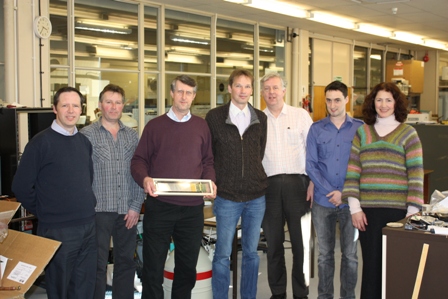
The Liverpool team involved in the detector build. From left: David Wells, David Seddon, Jim Thornhill, Petteri Pusa, Paul Nolan, Joseph McKenna and Janet Sampson. Jim Thornhill is holding a ALPHA detector module in his hands. The detector consists of 60 such modules.
Physicists at the University have carried out detailed spectroscopic measurements of antimatter.
The team, part of the ALPHA collaboration at CERN, in Geneva, had previously managed to trap antihydrogen atoms – the antimatter counterpart of hydrogen – routinely for long periods of time. The new findings build on this research to help further understanding of the origins of the Universe.
Particles that are known to exist in the Universe have their mirror image in antimatter, but with the opposite electrical charge. It is thought that when the Universe formed, matter and antimatter existed in equal measure, until they collided and annihilated, with the residual matter making up the planets of the solar system.
Although antimatter is known to exist – in the stars for example – scientists have questioned for many years why it is only matter that can be seen in our physical world today, and why Nature has expressed a preference for antimatter over matter. If antihydrogen atoms can be studied in detail, as ALPHA’s latest result suggests, they may provide a powerful tool for investigating this preference.
Liverpool Group leader, Professor Paul Nolan, said: “Despite the extreme technical difficulties involved, we have now shown that it is possible to carry out spectroscopic measurements with neutral antiatoms. ALPHA will continue to improve the achieved precision and help us to find out if the antiworld is hiding any secrets from us.”
Hydrogen is one of the most studied subjects in physics and its properties are known to extremely high precision. The group’s research has determined the first measurement of the anti-hydrogen spectrum.
Hydrogen atoms consist of an electron orbiting a nucleus. By firing light at them the atoms can be excited, with the electrons jumping to higher orbits, and eventually relaxing back to their so-called ground state by emitting light. The frequency distribution of the light emitted forms a very precisely measured spectrum that, in the matter world, is unique to hydrogen. Basic principles of physics say that antihydrogen should have an identical spectrum to hydrogen, and measuring this spectrum is the ultimate goal of the ALPHA collaboration.
The antiatoms annihilate immediately if they meet ordinary matter and therefore must be kept isolated from any material in the experiment in an ultra high vacuum and very low temperature environment. This is done using complex magnetic fields produced by superconducting magnets, forming a ‘magnetic bottle’ where the antihydrogen is stored.
The trapped atom quantum state can be changed by shining precisely tuned microwave radiation on the antiatom, with the consequence that the antiatom changes its magnetic orientation and escapes from the bottle. As this happens the antihydrogen atom annihilates on the ALPHA apparatus trap walls and is detected by a sensitive particle detector. The Silicon Vertex Detector is the main diagnostic tool for detecting anti-hydrogen in the experiment and was designed and constructed by staff in the Physics department using the facilities in the University’s Semiconductor Detector Centre .
Dr Petteri Pusa from the University’s Nuclear Structure group said: “We know exactly where and when a single antihydrogen atom meets ordinary matter – in practice the detector is a kind of 3D camera which sees the antihydrogen annihilation and is capable of imaging what’s going on inside the experiment.”
The findings are published in Nature.
